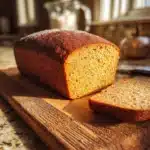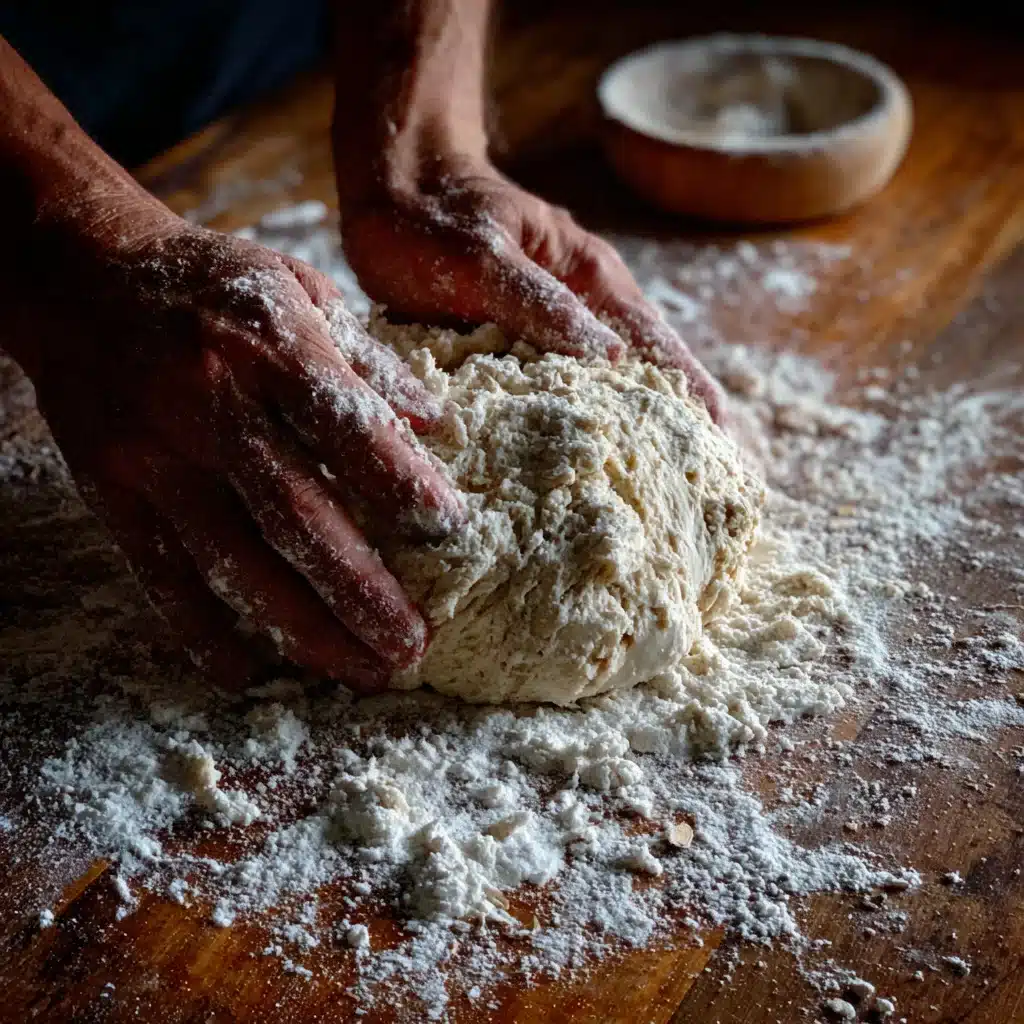Curious about the ezekiel bread recipe that’s both ancient and surprisingly relevant today? You’re in for a nourishing experience. This article explores the biblical roots, nutritional insights, and practical steps for making this wholesome loaf. Whether you’re baking for the first time or you’re a seasoned bread machine aficionado, this post covers it all, from ingredients to FAQs. We’ll even dive into questions like whether Ezekiel bread spikes sugar and its true health benefits. Plus, you’ll get my personal baking story, tips for beginners, and links to related breads like Italian Easter bread and clever carrot sourdough.
EZEKIEL BREAD RECIPE: An Ancient Loaf with Modern Benefits
Years ago, I stumbled onto the ezekiel bread recipe the same way I’ve stumbled onto many good things in life, through a baking fail. I was deep into sourdough at the time, nurturing my starter Clementine, when a friend handed me a tattered Bible page and said, “Bake this.” It was Ezekiel 4:9. Intrigued, I ground a few grains, mixed them up, and baked a very humble flatbread. It was dry, dense, and weirdly comforting.
Since then, I’ve adapted the original biblical bread into something delicious, digestible, and nutrient-rich, perfect for modern palates and even bread machines. If you’ve ever browsed your grocery store and seen sprouted grain loaves labeled “Ezekiel,” that’s the commercial take. But homemade? You control the quality, the grains, and the flavor.
What makes Ezekiel bread so special? It’s made from a blend of lentils, barley, millet, wheat, and beans, all soaked or sprouted for digestibility. The original scripture was never meant as a gourmet manual, it was survival food. Yet, with a few tweaks and ingredients like olive oil and honey, this ancient recipe transforms into a hearty, nutritious loaf.
In my kitchen in Mendocino, I’ve served this bread with olive tapenade, slathered it in almond butter, and even used it for garlic sourdough toast. For those managing blood sugar, it’s worth noting that Ezekiel bread has a low glycemic impact, more on that later.
And yes, it works in a bread machine too. But whether you hand-knead or automate, the results are worth it. So, grab your Ezekiel bread ingredients, warm your water to just the right temp (105–110°F), and let’s bake a loaf that’s both nourishing and timeless.
Before we jump into variations and nutritional details, let’s unpack what goes into the Ezekiel mix and why this ancient grain blend still matters today.
The Ingredients Behind Every Great Ezekiel Bread Recipe
The Biblical Foundation of the Ezekiel Bread Recipe

At the core of every ezekiel bread recipe is a powerful mix of ancient grains and legumes, straight from Scripture. This is no ordinary loaf, it’s inspired by Ezekiel 4:9, where ingredients were listed not for pleasure, but for survival. Today, we take that sacred list and craft it into something truly nourishing. A typical ezekiel bread recipe includes wheat, barley, millet, lentils, beans, and spelt, grains known for their protein and fiber content.
By grinding these into flour, whether with a grain mill or a high-speed blender, you’re building the foundation of a loaf that’s hearty, dense, and deeply satisfying. What sets the ezekiel bread recipe apart from typical whole wheat bread is the combination of grains and legumes. Together, they form a complete protein, something rare in plant-based diets. That’s a big reason why so many people looking for a more nutritious option turn to ezekiel bread recipes.
Optional Enhancements That Improve Texture and Flavor
When I first started experimenting with this recipe in my Mendocino kitchen, I followed the original ezekiel bread recipe almost to the letter. But I quickly learned how small adjustments could improve the final result without compromising its spiritual roots. Adding a tablespoon of lecithin helps soften the crumb, while a single egg boosts structure and richness. Olive oil and honey? Essential. They give the bread that subtle Mediterranean warmth and just enough sweetness.
Looking for low-gluten alternatives? My readers often compare this recipe to options like gluten-aware sourdoughs and FODMAP-friendly loaves. While Ezekiel bread does contain gluten, its sprouted ingredients can be easier to digest than conventional wheat bread.
Understanding what goes into an ezekiel bread recipe helps you bake with intention, and confidence. Now, let’s move to how to prepare it, step-by-step.
Print
Ezekiel Bread Recipe – 1 Ancient Loaf With Surprising Modern Health Perks
- Total Time: 1 hr 55 min (including rise time)
- Yield: 1 loaf 1x
- Diet: Vegetarian
Description
A hearty Ezekiel bread recipe inspired by the Bible, rich in sprouted grains and nutrients.
Ingredients
3 cups Ezekiel mix ground
1 cup warm water (105-110°F)
1/4 cup olive oil
1/4 cup honey
1 tsp salt
2 1/2 tsp instant yeast
1 tbsp lecithin (optional)
1 egg (optional)
Instructions
1. Grind grains and legumes to make Ezekiel flour.
2. Mix flour, salt, and yeast in a bowl.
3. In another bowl, mix water, olive oil, honey, egg (if using), lecithin (if using).
4. Combine wet and dry ingredients, knead for 8-10 minutes.
5. Let rise until doubled (1 hr), shape into loaf.
6. Let rise again 30-45 min, bake at 350°F for 35-40 min.
Notes
Sprouting grains before grinding enhances nutrition.
Pairs well with avocado, hummus, or nut butters.
- Prep Time: 20 min
- Cook Time: 35 min
- Category: Bread
- Method: Baking
- Cuisine: Biblical
Nutrition
- Serving Size: 1 slice
- Calories: 90
- Sugar: 2g
- Sodium: 150mg
- Fat: 3g
- Saturated Fat: 0.5g
- Unsaturated Fat: 2.5g
- Trans Fat: 0g
- Carbohydrates: 13g
- Fiber: 2g
- Protein: 4g
- Cholesterol: 10mg
Keywords: ezekiel bread recipe, biblical bread, healthy bread
How to Make Ezekiel Bread – Step-by-Step Instructions
Easy Method to Make the Ezekiel Bread Recipe by Hand or in a Bread Machine
Making your own ezekiel bread recipe at home starts with preparation and patience, but don’t worry, it’s straightforward. First, ensure you’ve ground your Ezekiel mix: 3 cups of whole grains and legumes, finely milled. Freshly ground flour retains nutrients and flavor better than store-bought.
Start by combining the dry ingredients: flour mix, instant yeast, and salt. Then in a separate bowl, mix warm water (around 105–110°F), olive oil, and honey. Add the wet mixture to the dry. If using, stir in an egg and a tablespoon of lecithin to soften the texture. Knead the dough for about 8–10 minutes until smooth. Let it rise in a warm spot until doubled, about one hour.
Shape it into a loaf and place it in a greased pan. Cover and let rise again for 30–45 minutes. Bake at 350°F for 35–40 minutes or until it sounds hollow when tapped. Let cool before slicing.
Bread Machine Adaptation for Busy Bakers
If you’re using a bread machine for ezekiel bread, place the ingredients in this order: water, oil, honey, egg (if using), flour, salt, and yeast. Use the whole wheat or basic cycle. Check the dough early in the mix cycle, add a tablespoon of flour or water if needed to adjust the texture.
This bread doesn’t rise sky-high like white sandwich loaves, but it’s dense, nutritious, and satisfying. It toasts beautifully and pairs well with everything from nut butter to tomato slices.
Want to compare other bread types? Check out our guide to low-FODMAP sourdough options or explore why some sourdoughs may contain gluten.
Now let’s explore why this ancient bread has such a powerful nutritional legacy.

Is Ezekiel Bread Actually Healthy?
Why the Ezekiel Bread Recipe Is a Nutritional Powerhouse
When people ask if the ezekiel bread recipe is actually healthy, the answer is a confident yes, and here’s why. Unlike refined breads stripped of fiber and nutrients, Ezekiel bread is made from a blend of whole grains and legumes, most of which are sprouted before grinding. Sprouting activates enzymes that improve digestion, increase nutrient absorption, and reduce anti-nutrients like phytic acid.
Each slice of this biblical bread contains all nine essential amino acids, making it a complete protein, something rare in plant-based foods. Plus, it’s rich in B vitamins, fiber, and minerals like iron and zinc. This makes the ezekiel bread recipe ideal for vegans, vegetarians, or anyone looking to improve gut health without sacrificing substance or satisfaction.
Another hidden perk? The complex carbs in the bread digest slowly, offering steady energy and avoiding blood sugar spikes. This is particularly important for people managing diabetes or insulin resistance.
Does Ezekiel Bread Spike Sugar? Here’s What to Know
A common concern is whether this bread raises blood glucose levels. The answer: not significantly. Thanks to its high fiber and protein content, Ezekiel bread has a lower glycemic index than most conventional breads. That means it digests more slowly and releases glucose gradually.
To further stabilize blood sugar, pair it with healthy fats or protein, think almond butter, eggs, or avocado. As I tell my sourdough students, blood sugar balance isn’t just about the food; it’s about what you eat with it. And if you’re curious how it stacks up next to sourdough, check out our sourdough health benefits guide or our post on how to eat sourdough for gut support.
With its nutrient-dense profile and blood sugar-friendly impact, the ezekiel bread recipe isn’t just healthy, it’s healing.
Before we wrap, let’s tackle a few frequently asked questions about this remarkable loaf.
Conclusion: Why You Should Try the Ezekiel Bread Recipe
The ezekiel bread recipe is more than just food, it’s a connection to tradition, nutrition, and mindful eating. Whether you bake it by hand or use a machine, you’re crafting something rooted in history and shaped for health.
From its protein-rich flour to its blood sugar-friendly nature, this loaf holds its own against modern wellness standards. Plus, it’s a perfect addition to a holistic diet alongside gut-friendly loaves like our clever carrot sourdough or low-FODMAP sourdoughs.
So bake boldly, tweak the recipe to your taste, and remember, this is bread with purpose.

Frequently Asked Questions About the Ezekiel Bread Recipe
Is Ezekiel bread actually healthy?
Yes, it is! The ezekiel bread recipe uses sprouted grains and legumes, offering complete proteins, fiber, B vitamins, and essential minerals. Its slow-digesting carbs help balance blood sugar, making it an excellent choice for daily nourishment.
What are the ingredients for Ezekiel bread?
The classic ezekiel bread recipe includes sprouted wheat, barley, lentils, millet, spelt, and beans—blended into flour. At home, many bakers add olive oil, honey, salt, yeast, and sometimes an egg or lecithin to soften the crumb and improve rise.
Where in the Bible is the recipe for Ezekiel bread?
The recipe inspiration comes from Ezekiel 4:9: “Take also unto thee wheat, and barley, and beans, and lentils, and millet, and spelt, and put them in one vessel…” While originally symbolic, today’s adaptations are real, nourishing loaves.
Does Ezekiel bread spike sugar?
Not typically. Because of its high fiber and protein, the ezekiel bread recipe has a low glycemic index. When paired with protein or fat, it’s an excellent option for blood sugar control.

